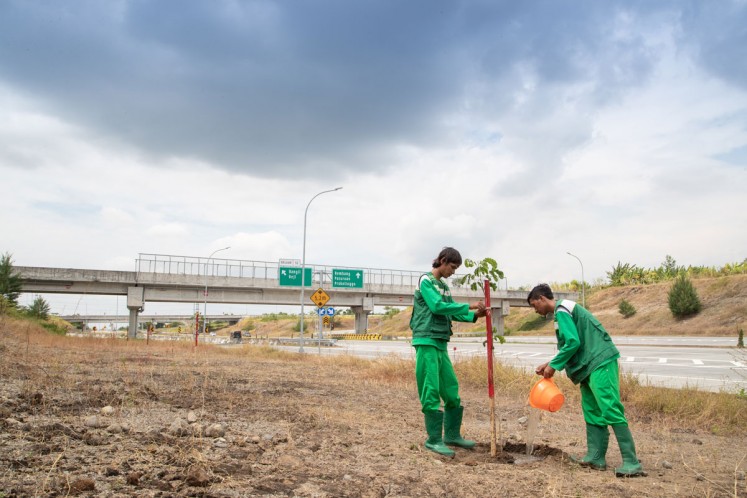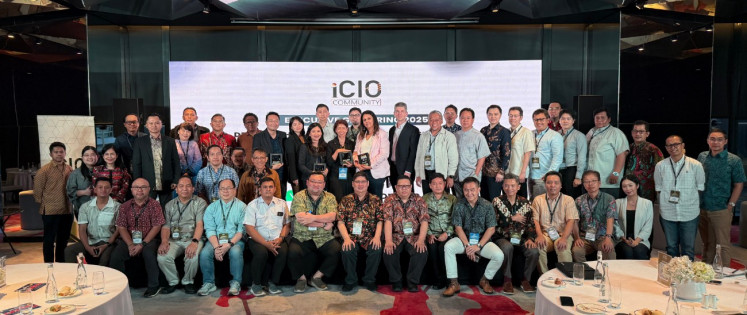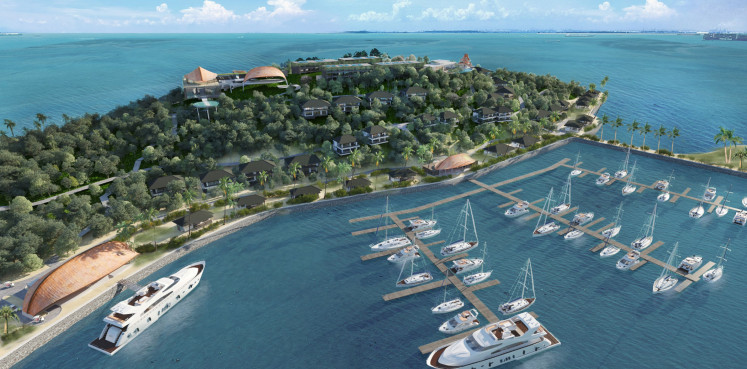Popular Reads
Top Results
Can't find what you're looking for?
View all search resultsPopular Reads
Top Results
Can't find what you're looking for?
View all search results‘Trembesi’ trees to provide shade along Gempol-Pasuruan toll road
Change text size
Gift Premium Articles
to Anyone
P
resident Joko “Jokowi” Widodo inaugurated on June 22 the Gempol-Pasuruan Section II toll road, which connects Rembang and Pasuruan.
The toll road, which was used for the 2018 Idul Fitri exodus, is expected to more effectively support land transportation across the island of Java in the future.
The construction of the Gempol-Pasuruan toll road focused not only on road infrastructure but the environment. A trembesi tree (Albizia saman), also known as a rain tree, is a good tree for shade and was chosen to provide shade along the 34.15-kilometer toll road to benefit road users.
The tree-planting drive along the Gempol-Pasuruan toll road is a joint effort between Djarum Foundation, through its Djarum Trees for Life (DTFL) program, and state-owned toll road operator PT Jasa Marga (Persero) Tbk.
“The Gempol-Pasuruan toll road is an important part of the trans-Java toll road, a major and very busy transportation route on Java Island.
“It is vital that we have green infrastructure that benefits us in the future. The trees will provide shade and absorb pollutants,” said Djarum Foundation vice president FX Supanji on Friday.
Supanji further explained that the foundation set a target to plant no fewer than 5,000 trembesi trees along the toll road.
The construction of the toll road is being conducted in several phases, with the road divided into several sections. Currently, according to Supanji, around 1,150 trees have been planted.
“We’ve planted trembesi trees along the Gempol-Pasuruan Section I toll road, which has a length of 15 kilometers. For sections II and III, it is still in progress. The total number of trees to be planted is 5,000 trees,” he said.
The trembesi tree, a forest tree with a Latin name of either Samanea saman or Albizia saman, was chosen because of its special characteristics. The tree is capable of storing water and helps maintain soil fertility. The tree also has a high CO2 absorption level. The tree’s canopy has a diameter of 15 meters, and one trembesi tree is capable of absorbing 28.5 tons of CO2 annually.
“Five thousand trembesi trees planted along the Gempol-Pasuruan toll road can absorb a maximum of 142,000 tons of carbon dioxide ten years after being planted. This is a very effective way to lower the pollutant level along the toll road,” Supanji explained.
Djarum Trees for Life has planted shade trees not only along the Gempol-Pasuruan toll road, but also along all trans-Java toll roads. Along the 36.27-kilometer Surabaya-Mojokerto toll road, Djarum Trees for Life has planted 3,900 out of the targeted 5,000 trembesi trees. In 2016, the foundation planted 12,979 trembesi trees along the 116-kilometer Tol Cikopo-Palimanan (Cipali) toll road.
“Since we planted trembesi trees along 2,150 kilometers of road on Java and Madura islands, we have reaped the benefits. That’s why we decided to continue with the drive and plant more trees along trans-Java toll roads. We hope the trees can absorb as much carbon dioxide as possible along major and busy routes in Indonesia,” he added.
Periodic Maintenance
More than just planting the trees, Djarum Trees for Life is also committed to taking care of the trees for a period of three years after planting. The maintenance is done periodically and systematically based on data about the trees. The maintenance includes fertilizing the trees, watering them and weeding out and even pruning them. Any damaged or dead tree will be replaced with a new one.
“We also pay attention to the aspect of functionality and the security of the road users. We want the trees to not only serve their function, but also not to endanger road users,” Supanji explained.
He said that a distance between two trees should be at least 15 meters so that they can provide maximum shade and so their branches do not get entangled.
The periodic pruning process is to ensure the branches do not grow too low and too long, he said.
The trembesi trees are cultivated in the Plant Nursery Center (PPT), established and managed by Djarum Foundation since 1979. Situated in Kudus regency, Central Java, the center has cultivated various rare species of plants. The center also cultivates conservation plants, both fruit and non-fruit trees, such as trembesi trees, walnut trees, mahogany trees, tamarind trees and randualas or alang trees (Bombax Ceiba).
Djarum Foundation cultivates around 100,000 tree seedlings each year. The foundation is committed to this effort, and has a stake in helping the country to be green and to promote a better quality of life for future generations.











